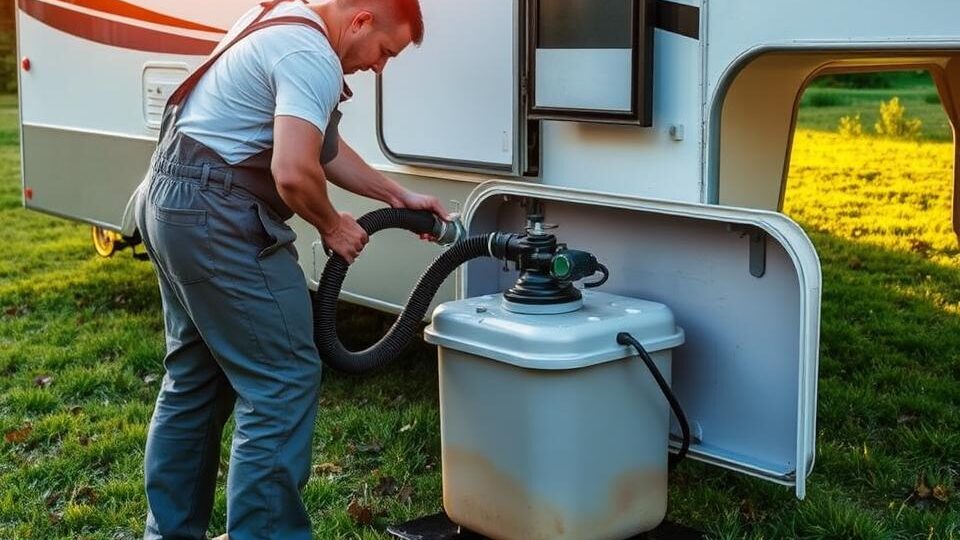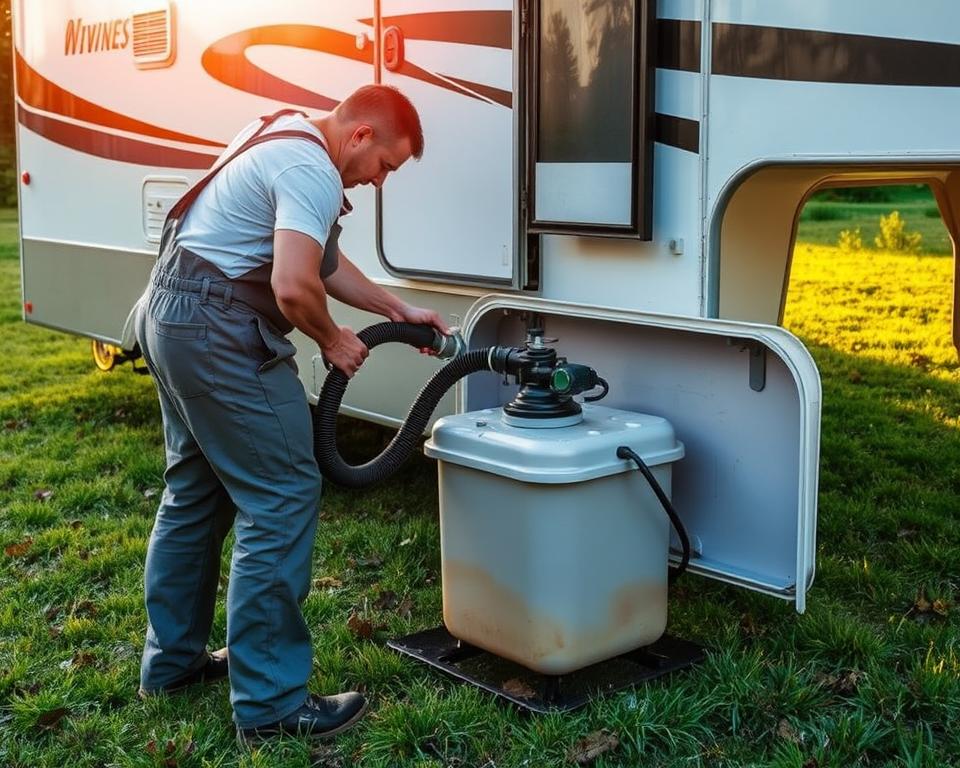
Budgeting Wisely for Pasadena RV Septic Tank Pumping: A Cost Management Guide
RV Septic Tank Service: Essential Care Tips
Curious about what goes on to your RV’s Septic tank as you’re on the road? It’s not just dodging bad smells. Keeping your RV Septic tank well-maintained guarantees smooth travels. A well-maintained system prevents messy situations and costly fixes. Yet, many ignore this critical care. Within this article, we break down the necessity for regular RV black tank pump. We’ll focus on the value of upkeep and provide tips for maintaining your recreational vehicle’s Septic tank. Prepare for carefree adventures!
Major Highlights
- Consistent RV Septic tank service is critical for top performance.
- Knowing your RV Septic system assists avoid costly repairs.
- Routine maintenance stops unpleasant odors and clogs.
- Set a pumping schedule matched with your usage.
- Employ best practices for dumping your holding tanks.
- Bypass common mistakes to extend the life of your Septic system.
- Recognize when to enlist professional help for Septic services.
Understanding RV Septic Systems
An RV Septic system is essential for any camper. It contains multiple holding tanks that handle waste effectively. You’ll find three critical tanks in an RV: the fresh water, the gray, and the black tank. The fresh water tank delivers clean water for drinking and cooking. Meanwhile, the gray tank stores wastewater from sinks and showers, ensuring cleanliness. The black tank, specifically for toilet waste, also has a vent to cut odors.
Maintaining a healthy camper sewage system calls for knowing how these parts connect. Frequent checks of the tank levels are necessary to prevent overflow and secure everything runs without a hitch. Getting to know the termination valves is important too. These valves are pivotal in effectively handling waste disposal. By understanding these components, you can keep your RV in top condition and relish your travels without extra stress.
| Reservoir | Role | Volume |
|---|---|---|
| Fresh Water Tank | Supplies drinking and cooking water | 30-100 gallons |
| Gray Tank | Stores wastewater from sinks and showers | 30-60 gallons |
| Black Tank | Stores toilet waste | 30-50 gallons |
Importance of Regular RV Septic Tank Service
Timely RV Septic tank service is central to ensuring your system reliable and long-lasting. Without proper maintenance, you could face system failures, bad smells, and costly repairs—issues that disrupt your adventures.
Overlooking the upkeep of your RV’s Septic system may cause it to back up. This not only affects your RV’s function but also your comfort levels. A clean and regularly cleaned system is essential for trouble-free trips, offering you a peaceful travel experience.

Regular maintenance extends your sewage system’s lifespan and keeps a clean living space. Monitoring your Septic tank lets you detect issues early. This pre-planning reduces costs and stress, giving you confidence during your journeys.
Ideal RV Septic Tank Pumping Schedule
Figuring out the ideal schedule for RV Septic tank maintenance hinges on the vehicle’s usage. For those constantly on the road or living in their RVs, it’s wise to drain the black tank every three to five days. This practice keeps cleanliness and stops unexpected issues during voyages.
Weekend adventurers can generally wait until they return home to pump their Septic tank. Leaving waste in the tank too long, though, can cause build-up that hinders the tank’s function and smell control. It’s important to monitor the tank’s level closely, readying for disposal once it hits ≈66% full to keep everything running properly.
The capacity of your Septic system, along with how you use your RV, will determine when to pump. Knowing these aspects boosts your RV’s performance and cuts the dangers of poor waste management.
| Travel Style | Recommended Pumping Frequency | When to Pump Right Away |
|---|---|---|
| Frequent Usage | Every 3-5 days | Tank is two-thirds full |
| Weekend Trips | After return home | Bad smells or lazy draining |
| Extended Trips | Every 2-3 days | Gauge shows near full |
Best Practices for Emptying RV Holding Tanks
Effectively managing a recreational vehicle’s holding tanks is crucial for a enjoyable camping experience. Start by draining the black tank first. This approach allows the gray water to flow through and help rinse out the hose. Be sure the use of a high-quality sewer hose for a secure connection and to cut spills. Once the tanks are emptied, fully flushing the black tank is crucial. Employing a built-in black tank flush or comparable alternatives can dramatically cut residue.
After the emptying process, it’s vital to close both valves firmly. This action is necessary to keep a fully operational Septic system. Additionally, RV owners must rely on dump stations properly and follow local laws. Routine cleaning practices for recreational vehicle Septic tanks are essential. They protect the system’s optimal functionality and prevent future odors.
How to Stop RV Odors & Clogs
To control odors and stop clogs in your RV, being meticulous is key. The task kicks off with making sure enough water in the holding tanks. Adequate water aids in breaking down waste efficiently, cutting bad smells.
Choosing suitable toilet paper is important in this process. Opt for RV-safe toilet paper that dissolves quickly, stopping clogs. This simple adjustment greatly supports maintaining seamless waste flow.
Employing enzyme-based treatments can further boost waste decomposition and odor control. These natural solutions assist keep your RV smelling fresh. It’s also important to regularly examine vent pipes for obstructions to guarantee good airflow and stop odors from infiltrating your living area.
Common Mistakes to Avoid with RV Septic Maintenance
Keeping your RV’s Septic system the right way is essential for its efficiency and longevity. When non-biodegradable items like wipes or feminine products are flushed, they can cause major blockages. These blockages can cause various problems that are difficult to resolve.
Not using enough water when flushing can also hurt the system. It causes waste buildup, resulting in nasty scents and potential damage. Furthermore, a common mistake at full hook-up sites is leaving the black tank valve open. This causes waste to collect at the tank’s bottom.
Preventive measures include consistently flushing and rinsing tanks after emptying them. Failing to keep up maintenance can snowball into significant issues necessitating pricey repairs. Being proactive and knowledgeable safeguards both your RV and your finances.
When to Seek Professional RV Septic Services
Recognizing when to seek professional RV Septic services is critical for maintaining a healthy Septic system. Some indicators suggest the need for expert intervention. Should you spot slow-draining tanks or experience persistent foul odors coming from your RV, it is wise to act promptly. These signs often indicate underlying issues that demand a thorough Septic tank service for resolution.
Visible leftover waste after emptying can also indicate problems within your Septic system. This situation may not resolve with routine maintenance and may call for the use of specialized equipment. Professionals are ready to address complex challenges via tools, such as high-pressure water jets, to ensure a complete cleaning process.
Prompt professional assistance can make a major difference. Small problems can quickly turn into more severe complications without proper care. Investing in professional RV Septic services preserves the integrity of your system and extends its lifespan.
| Problem Indicators | Recommended Action |
|---|---|
| Slow draining tanks | Contact professional RV Septic services for assessment |
| Persistent foul odors | Schedule Septic tank service for diagnostics |
| Visible leftover waste | Seek immediate assistance from a professional |
| Frequent clogs | Consider expert cleaning solutions |
Long-Term Care for Your RV Septic System
Long-term care for RV Septic systems calls for attention past basic pump-outs. Performing deep cleaning of tanks every few months avoids buildup and lengthens system life. Checking dump valve seals on schedule stops leaks. Additionally, sanitizing the system keeps it clean and functioning well.
It’s crucial to monitor tank sensors to confirm they work correctly. Incorrect readings may cause over-filling, hurting performance. Regular sensor checks and adjusting maintenance schedules can prevent this problem.
| Task | Frequency | Outcome |
|---|---|---|
| Deep Cleaning Tanks | Every 3-6 months | Keeps flow smooth |
| Inspect Dump Valve Seals | Monthly | Maintains seal integrity |
| Sanitize System | Every 6 months | Controls bacteria |
| Monitor Tank Sensors | Monthly | Prevents over-fill |
Forward-thinking maintenance is vital to your RV Septic system’s long-term health. It lays the groundwork for pleasant and carefree travel experiences.
All In Sanitation: Trusted RV Septic Partner
All In Sanitation excels at crafting RV Septic services that match each client’s specific needs. Whether it’s regular pump-outs or full tank cleaning, they grasp the vital role of a well-functioning Septic system in your RV’s performance.
With extensive expertise in RV Septic systems, All In Sanitation offers top-tier guidance on maintenance and care. Their team is well-versed in the specific challenges RV owners meet and provides effective solutions when troubles arise.
Selecting All In Sanitation allows RV enthusiasts dive in their journeys, leaving Septic concerns to a trustworthy ally. Their dedication to excellent service brings confidence and improves the pleasure of adventures on the open road.
The Final Word
Caring for your RV Septic tank is critical for smooth travels. It’s important to know your system and stay on top of regular services. This secures you won’t face unexpected issues on your journey. These key steps include frequent pumping and practicing sound waste management practices.
Proper long-term care holds your system in top shape. By implementing the provided maintenance tips, you can improve your travel experience. This strategy prevents expensive repairs later. Remember, sidestepping common errors and understanding when to obtain professional help are key.
Bottom line, being proactive in your RV Septic system’s maintenance guarantees a hassle-free adventure. It allows you to focus on making lasting memories. So, embrace these steps to heart and relish your road trips to their fullest.